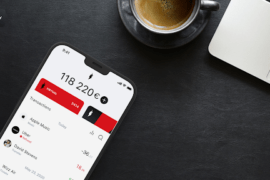
When times get tough financially, finding the right solution to gain the help you need can seem daunting. With different loan types available, from unsecured personal loans to credit cards and more, it’s easy to find yourself wondering which is best for you and your financial situation. Even with the ability to compare personal loans online, it can still feel daunting at first. A Personal Line Of Credit might not be the first solution that comes to mind, but this loan/credit hybrid offers flexible borrowing with the additional benefit of offering you the ability to borrow money incrementally.
If you’re looking to get started with a personal line of credit, you might be wondering where is best to begin. From banks, to online alternatives, understanding how they work and the details involved can help you get started with confidence. Here’s what you need to know.
What Is A Personal Line Of Credit?
A personal line of credit, while technically a loan, is not too dissimilar to a credit card. These open-ended loans offer the borrower the opportunity to withdraw funds as they need to, rather than all at once. Once you have been approved, you can borrow up to the approved amount, but can do so over time, as you need them. In a similar way to credit cards, you’ll only pay interest on the amount that you’ve taken out of the loan to use, though these rates are typically variable and will depend on the market-wide interest rates dependant on your country or financial body.
The borrower in question can borrow as much from the line of credit as they like at any one time, providing they do not exceed the set limit. They must meet the minimum payments as agreed, though this amount may differ depending on how much you’ve borrowed and the remaining time period left on the agreed loan.
How Do They Work?
A personal line of credit, as with any loan, has set time period. Unlike a credit card which can often be unlimited in terms of time frames, a line of credit will require you to adhere to certain deadlines along the way. The first is referred to as the draw period. During the draw period, the bank will give you a check book or a card to use in order to ‘borrow’ or use the money in the account, or you can transfer to your main account. However, after this has ended, no more money can be withdrawn from the loan. You can transfer the remaining funds to your checking account at the end of the draw period if you need the money, but anything that remains won’t be accessible.
It’s important to note, however, that you don’t have to repay all of what was borrowed during this time. Following on from the draw period, you’ll enter the ‘repayment period’, during which time you’ll need to meet the minimum required payments needed to repay the loan before the deadline.
Some loans will come with additional annual and you may face limits on what you can borrow yearly, but this will depend on the lender that you choose to use. It’s important to make note of these details before you apply to ensure you’re getting the right line of credit for your needs and situation.
Other Lines Of Credit
Alongside personal lines of credit, you can also apply for two other options – Home Equity Line of Credit, and Overdraft Line of Credit. Each offer different uses and benefits dependant on your situation:
Home Equity Line Of Credit (HELOC)
If you’re a homeowner, a Home Equity Line Of Credit (HELOC) can offer you access to financial relief by using some of the money otherwise locked in your home. While this is a secured line of credit, it does offer you access to the cash you need to cover a range of expenses, from home renovations and fixes, to debt consolidation or even education costs for you or your children. As with a personal line of credit, you can access the agreed amount and use and reuse the money as you repay it along the way.
Claim up to $26,000 per W2 Employee
- Billions of dollars in funding available
- Funds are available to U.S. Businesses NOW
- This is not a loan. These tax credits do not need to be repaid
Due to the money available in a home, a HELOC offers larger amounts of cash than you may get from a personal line of credit, so are used mainly for bigger purchases or investments like buildings, education or medical bills.
Overdraft Line Of Credit
An Overdraft Line Of Credit is a loan that is attached to your checking account, offering protection on your account where needed. It can cover bills, checks and more if your account runs short on funds, and in some cases, you may able to access the line of credit if you need emergency funds. This will depend on the bank or institution you are using, so be sure to do your research before applying for an overdraft line of credit.
Without this protection, you could face rejected payments where money isn’t available, or an unapproved overdraft that can be expensive in terms of fees and penalty payments. For this reason, an overdraft line of credit could offer you the peace of mind that no important bills or payments will bounce or cost you more than necessary. They do have fees associated, but you won’t pay interest on anything more than what you’ve used.
Secured vs. Unsecured
While personal lines of credit are usually unsecured, HELOC lines of credit are considered to be ‘secured’, which means they can only be taken out against your home to act as a form of asset. This can usually translate to lower interest rates and larger amounts of money, but secured loans do come with their risks.
If you fail to make the repayments on time when the repayment period rolls around, you risk losing your home. While this is usually a last resort where solutions cannot be reached, it’s still a very real risk that you need to consider before applying for a HELOC.
Unsecured loans, on the other hand, offer financial support without needing to secure the money against any of your assets. The risk is higher on the lender’s part, however, so you’ll often need a much higher credit score than with a secured loan and will need to take into account that interest rates may be higher. You also can’t borrow as much as with a HELOC, which is why a personal line of credit is best suited to smaller investments.
How To Apply For A Line Of Credit
If you’re applying for a personal line of credit, the process can differ depending on whether you’re applying with a bank or online lender. You’ll typically need a fair or high credit score to prove that you are trustworthy financially, with an established record and proof of your employment status, earnings and financial history.
In a lot of cases, a financial institution will require you to have an existing checking account with them before you can apply. Regardless, however, you will need to meet several criteria which may differ between lenders. Typically, however, these will focus on:
- Your Credit Score – The higher your credit score, the better!
- Your Payment History – Do you have an established history of meeting repayments? If so, you have a higher chance of securing better rates and options.
- Your Financial Condition – If you have a good credit score, but your current financial situation is bad, you could face difficulty getting approved. Banks and institutions will usually look at debt-to-income ratio, cash on hand and your net worth.
Things To Consider
Lines of Credit, whether personal, home equity or overdraft-based, there are both positives, and considerations that you should make note of.
The Positives
On the positive end of the spectrum, you can benefit from the fact that you’ll only be repaying interest on what you’ve borrowed, rather than the full line of credit limit at any one time. In addition, you could face interest rates that are significantly lower than with a personal loan. This isn’t always the case, so it’s important to do your research, but a personal line of credit can be a considerably more affordable option for finance than a standard loan.
With some lenders or banks, you may only be able to access the funds in your account via a check or monetary transfer. In these cases, you could find it easier to stick to a budget. As you can’t just swipe your card or hand over cash, you could keep better track of what you’re spending and stick to what you can afford. You will still have the option of tapping into the line of credit as an emergency funding source when it’s needed, which can offer peace of mind, but it will mean stopping to think about it before you get access to the funds.
Other pros for personal lines of credit, include:
- You only borrow what you need at the time
- Most banks and institutions will offer flexible repayment options
- You have access to funds as and when you need them
- In most cases, the APR will be lower than with a credit card or personal loan
- Some banks or lenders might offer secured alternatives for lower interest rates
- You can draw up to 100% of your credit limit, often without restriction
- Can be good for long-term projects where final costs are variable over time
- Can be useful for meeting temporary cash shortfalls without looping into a long-term loan
What To Watch Out For
As with all loan types, there are things you need to be aware of before applying for a loan. Many of the risks of a personal loan of credit can depend on you and your existing financial habits, but should be taken into account regardless when determining if this is the solution for you.
Personal lines of credit are easy to use, offering quick access to funds and while some will only be accessible by transfer or cheques, some banks and lenders might give you a credit card which can make it much easier to spend. If you typically overspend, this could mean going over your budget far too easily. Similarly, if you have a poor credit history, you might not even qualify for the line of credit at all. Unsecured lines of credit require a strong credit score to showcase your reliability as a borrower, so you need to ensure that your finances are in order before application.
Other things to watch out for include:
- Variable interest rates can mean paying back higher rates at times
- Annual fees are applicable on some lines of credit
- It can be difficult to forecast the repayments due to fluctuating interest
- You may need an account at the bank or institution
- You will need a fair or good credit score
- A high balance on the line of credit could damage your credit score
What Can I Use It For?
A personal line of credit can essentially be used for any expense you have that the amount will cover, but it is advised that you are careful with what you use the money for. Using the money for everyday expenses can make you too reliant on the extra funds and, when you consider the fixed time frames in which you can utilise the money, this could become a problem in the future. For this reason, a personal line of credit makes a convenient solution for home repairs, unexpected expenses, medical costs or help with education-based costs.
Uses for a personal line of credit could include:
- Resolving funding challenges, such as with weddings, home replacements, car breakdowns etc.
- If you have an irregular income, a personal line of credit may help on occasions where your bills come before your pay check, but take care that you don’t rely on this.
- Emergency situations, such as unexpected bills
- Grasping opportunity, such as with starting a business, taking advantage of deals on holidays, appliances or other expenses.
A personal line of credit can be a useful thing to fall back on when times get tough financially, but you need to be aware of the uses, pros, cons and requirements before you go to apply. Hopefully this guide has helped you in starting up your own line of credit.



